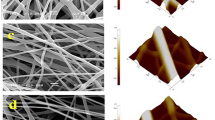Abstract
Recently, attempts have been made to develop nanofiber tubes suitable for nerve regeneration made of biodegradable nanofibers. Among all polymeric nanofibers, poly(ε-caprolactone) (PCL) is distinctively known for better mechanical stability and poly(l-lactic acid) (PLLA) for relatively faster biodegradability. Our purpose of study is to investigate their blending compatibility and the ability to form nanofiber tubes via electrospinning. We electrospun the PCL–PLLA nanofiber tubular using different blend ratios of PCL–PLLA. The electrospun nanofibers were continuously deposited over high speed rotating mandrel to fabricate nanofiber tubes having inner diameter of 2 mm and the wall thickness of 55–65 μm. The diameters of nanofibers were between 715 and 860 nm. The morphologies of PCL–PLLA nanofiber tubes were examined under scanning electron microscope, and showed better structural stability and formability than the neat PLLA nanofibers. Fourier transform infrared spectroscopy study revealed that the PCL–PLLA blend nanofiber exhibited characteristic peaks of both PCL and PLLA and was composition-dependent. Raman and X-ray diffraction studies showed that the increasing PCL ratio in the PCL–PLLA blend increased crystallinity of PCL–PLLA blends. Differential scanning calorimetry revealed recrystallization peaks in PCL–PLLA blends ratios of 1:2 and 1:1. Based on characterization, the electrospun PCL–PLLA nanofiber tubes is considered to be a better candidate for further in vivo or in vitro investigation, and resolve biocompatibility issues in tissue engineering.





Similar content being viewed by others
References
Ku SH, Park CB (2010) Biomaterials 31:9431. doi:10.1016/j.biomaterials.2010.08.071
Panseri S, Cunha C, Lowery J, Carro UD, Taraballi F, Amadio S, Vescovi A, Gelain (2008) BMC Biotechnol 8:39. doi:10.1186/1472-6750-8-39
Ramakrishna S, Jose R, Archana PS, Nair AS, Balamurugan R, Venugopal J, Teo WE (2010) J Mater Sci 45:6283. doi:10.1007/s10853-010-4509-1
Xie J, MacEwan MR, Schwartz AG, Xia Y (2010) Nanoscale 2:35. doi:10.1039/B9NR00243J
Wang S, Cai L (2010) Polymers for fabricating nerve conduits. Int J Polym Sci 2010. doi: 10.1155/2010/138686
Lee SJ, Oh SH, Liu J, Soker S, Atala A, Yoo JJ (2008) Biomaterials 29:1422. doi:10.1016/j.biomaterials.2007.11.024
Yang F, Murugan R, Ramakrishna S, Wang X, Ma YX, Wang S (2004) Biomaterials 25:1891. doi:10.1016/j.biomaterials.2003.08.062
Patra SN, Easteal AJ, Bhattacharyya D (2009) J Mater Sci 44:647. doi:10.1007/s10853-008-3050-y
Bini TB, Gao S, Wang S, Ramakrishna S (2006) J Mater Sci 41:6453. doi:10.1007/s10853-006-0714-3
Tian L, Prabhakaran MP, Ding X, Kai D, Ramakrishna S (2012) J Mater Sci 47:3272. doi:10.1007/s10853-011-6166-4
Zong X, Kim K, Fang D, Ran S, Hsiao BS, Chu B (2002) Polymer 43:4403. doi:10.1016/S0032-3861(02)00275-6
Xu CY, Inai R, Kotaki M, Ramakrishna S (2004) Biomaterials 25:877. doi:10.1016/S0142-9612(03)00593-3
Marelli B, Alessandrino A, Farè S, Freddi G, Mantovani D, Tanzi MC (2010) Acta Biomater 6:4019. doi:10.1016/j.actbio.2010.05.008
Carfì-Pavia F, La-Carrubba V, Brucato V (2009) Int J Mater Form 2:713. doi:10.1007/s12289-009-0574-x
Hollister SJ (2005) Nat Mater 4:518. doi:10.1038/nmat1421
Gross RA, Kalra B (2002) Science 297:803. doi:10.1126/science.297.5582.803
Zeng J, Chen X, Liang Q, Xu X, Jing X (2004) Macromol Biosci 4:1118. doi:10.1002/mabi.200400092
Kim K, Yu M, Zong X, Chiu J, Fang D, Seo YS, Benjamin SH, Benjamin C, Hadjiargyrou M (2003) Biomaterials 24:4977. doi:10.1016/S0142-9612(03)00407-1
Elzein T, Nasser-Eddine M, Delaite C, Bistac S, Dumas P (2004) J Colloid Interf Sci 273:381. doi:10.1016/j.jcis.2004.02.001
He J, Qin Y, Cui S, Gao Y, Wang S (2011) J Mater Sci 46:2938. doi:10.1007/s10853-010-5169-x
Furukawa T, Sato H, Murakami R, Zhang J, Noda I, Ochiai S, Ozaki Y (2006) Polymer 47:3132. doi:10.1016/j.polymer.2006.03.010
He Y, Inoue Y (2000) Polym Int 49:623. doi:10.1002/1097-0126(200006)49:6<623:AID-PI435>3.0.CO;2-8
Taddei P, Tinti A, Fini G (2001) J Raman Spectrosc 32:619. doi:10.1002/jrs.723
Hartman O, Zhang C, Adams EL, Farach-Carson MC, Petrelli NJ, Chase BD, Rabolt JF (2010) Biomaterials 31:5700. doi:10.1016/j.biomaterials.2010.03.017
Meng ZX, Zheng W, Li L, Zheng YF (2010) Mat Sci Eng C 30:1014. doi:10.1016/j.msec.2010.05.003
Liu D, Yuan X, Bhattacharyya D (2012) J Mater Sci 47:3159. doi:10.1007/s10853-011-6150-z
Reneker DH, Yarin AL, Fong H, Koombhongse S (2000) J Appl Phys 87:4531. doi:10.1063/1.373532
Yang JM, Chen HL, You JW, Hwang JC (1997) Polym J 29:657. doi:10.1295/polymj.29.657
Kim CH, Cho KY, Choi EJ, Park JK (2000) J Appl Polym Sci 77:226. doi:10.1002/(SICI)1097-4628(20000705)77:1<226:AID-APP29>3.0.CO;2-8
Acknowledgements
This work was supported by Grant-in-Aid for Global COE Program by the Ministry of Education, Culture Sports Science, and Technology, Japan.
Author information
Authors and Affiliations
Corresponding authors
Rights and permissions
About this article
Cite this article
Khatri, Z., Nakashima, R., Mayakrishnan, G. et al. Preparation and characterization of electrospun poly(ε-caprolactone)-poly(l-lactic acid) nanofiber tubes. J Mater Sci 48, 3659–3664 (2013). https://doi.org/10.1007/s10853-013-7161-8
Received:
Accepted:
Published:
Issue Date:
DOI: https://doi.org/10.1007/s10853-013-7161-8




